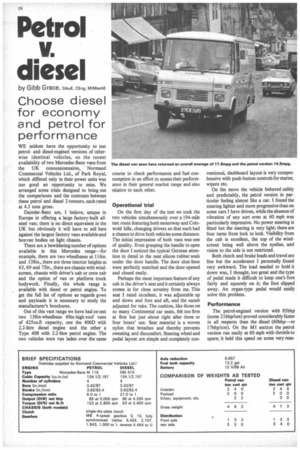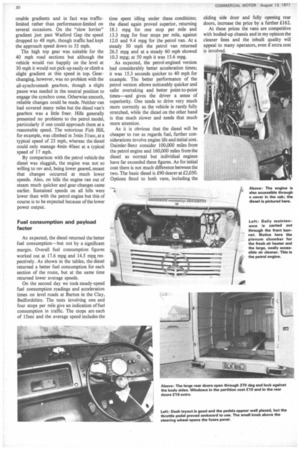Petrol
Page 30

Page 32

If you've noticed an error in this article please click here to report it so we can fix it.
V.
diesel
by Gibb Grace, DAuE. CEng, MIMechE
Choose diesel for economy and petrol for performance
WE seldom have the opportunity to test petroland diesel-engined versions of otherwise identical vehicles, so the recent availability of two Mercedes-Benz vans from the UK concessionnaires, Normand Commercial Vehicles Ltd., of Park Royal, which differed only in their power units was too good an opportunity to miss. We arranged some trials designed to bring out the comparisons and the contrasts between these petrol and diesel 2-tonners, each rated at 4.3 tons gross.
Daimler-Benz are, I believe, unique in Europe in offering a large factory-built ailsteel van; there is no direct equivalent in the UK but obviously it will have to sell here against the largest factory vans available and boxvan bodies on light chassis.
There are a bewildering number of options available in this Mercedes range—for example, there are two wheelbases at 116in. and I38in., there are three interior heights at 63, 69 and 75in., there are chassis with windscreen, chassis with driver's cab or crew cab and the option of van or platform truck bodywork. Finally, the whole range is available with diesel or petrol engine. To get the full list of options as regards gvws and payloads it is necessary to study the manufacturer's brochures.
Out of this vast range we have had on test two 138in-wheelbase 69in-high-roof vans of 425cu.ft capacity, one the 406D with 2.2-litre diesel engine and the other a Type 408 with 2.2-litre petrol engine. The two vehicles were run laden over the same course to check performance and fuel consumption in an effort to assess their performance in their general market range and also relative to each other.
Operational trial
On the first day of the test we took the two vehicles simultaneously over a 194-mile test route featuring both motorway and Cotswold hills, changing drivers so that each had a chance to drive both vehicles some distance. The initial impression of both vans was one of quality. Even grasping the handle to open the door I noticed the typical German attention to detail in the neat silicon rubber seals under the door handle. The door shut-lines were perfectly matched and the door opened and closed easily.
Perhaps the most important feature of any cab is the driver's seat and it certainly always comes in for close scrutiny from me. This seat I rated excellent, it was adjustable up and down and fore and aft, and the squab adjusted for rake. The cushion, like those on so many Continental car seats, felt too firm at first but just about right after three or four hours' use. Seat material is a woven nylon that breathes and thereby prevents sweating and discomfort. Steering wheel and pedal layout are simple and completely con
ventional, dashboard layout is very comprehensive with push-button controls for starter, wipers etc.
On the move the vehicle behaved safely and predictably, the petrol version in particular feeling almost like a car. I found the steering lighter and more progressive than on some cars I have driven, while the absence of vibration of any sort even at 60 mph was particularly impressive. No power steering is fitted but the steering is very light; there are four turns from lock to lock. Visibility from the cab is excellent, the top of the windscreen being well above the eyeline, and vision to the side is not restricted.
Both clutch and brake loads and travel are fine but the accelerator I personally found very awkward. The load needed to hold it down was, I thought, too great and the type of pedal made it difficult to keep one's foot fairly and squarely on it; the foot slipped away. An organ-type pedal would easily solve this problem.
Performance
The petrol-engined version with 85bhp (some 21bhp/ton) proved considerably faster in all respects than the diesel (60bhp—or I7bhp/ton). On the M1 section the petrol version ran easily at 60 mph with throttle to spare; it held this speed on some very reas onable gradients and in fact was trafficlimited rather than performance-limited on several occasions. On the "slow lorries" gradient just past Watford Gap the speed dropped to 48 mph, though traffic had kept the approach speed down to 55 mph.
The high top gear was suitable for the 40 mph road sections but although the vehicle would run happily on the level at 30 mph it would not pick-up easily or climb a slight gradient at this speed in top. Gearchanging, however, was no problem with the all-synchromesh gearbox, though a slight pause was needed in the neutral position to engage the synchro cone. Otherwise smooth, reliable changes could be made_ Neither van had covered many miles but the diesel van's gearbox was a little freer. Hills generally presented no problems to the petrol model, particularly if one could approach them at a reasonable speed. The notorious Fish Hill, for example, was climbed in 3min 31sec, at a typical speed of 23 mph, whereas the diesel could only manage 4min 40sec at a typical speed of 17 mph.
By comparison with the petrol vehicle the diesel was sluggish, the engine was not so willing to rev and, being lower geared, meant that changes occurred at much lower speeds. Also, on hills the engine ran out of steam much quicker and gear-changes came earlier. Sustained speeds on all hills were lower than with the petrol engine but this of course is to be expected because of the lower power output.
Fuel consumption and payload factor As expected, the diesel returned the better fuel consumption—but not by a significant margin. Overall fuel consumption figures worked out at 17.6 mpg and 14.5 mpg respectively. As shown in the tables, the diesel returned a better fuel consumption for each section of the route, but at the same time returned lower average speeds.
On the second day we took steady-speed fuel consumption readings and acceleration times on level roads at Barton in the Clay, Bedfordshire. The tests involving one and four stops per mile give an indication of fuel consumption in traffic. The stops are each of 15sec and the average speed includes the time spent idling under these conditidns; the diesel again proved superior, returning 18.1 mpg for one stop per mile and 13.3 mpg for four stops per mile, against 12.0 and 9.4 mpg for the petrol van. At a steady 30 mph the petrol van returned 26.5 mpg and at a steady 60 mph showed 10.3 mpg; at 50 mph it was 15.6 mpg.
As expected, the petrol-engined version had considerably better acceleration times; it was 15.3 seconds quicker to 40 mph for example. The better performance of the petrol version allows noticeably quicker and safer overtaking and better point-to-point times—and gives the driver a sense of superiority. One tends to drive very much more correctly as the vehicle is rarely fully stretched, while the diesel on the other hand is that much slower and needs that much more attention.
As it is obvious that the diesel will be cheaper to run as regards fuel, further considerations involve engine life and initial cost. Daimler-Benz consider 100,000 miles from the petrol engine and 160,000 miles from the diesel as normal but individual engines have far exceeded these figures. As for initial cost there is not much difference between the two. The basic diesel is £90 dearer at £2,050. Options fitted to both vans, including the sliding side door and fully opening rear doors, increase the price by a further £162.
At these prices the vans are competitive with bodied-up chassis and in my opinion the cleaner lines and the inbuilt quality will appeal to many operators, even if extra cost is involved.




















































































